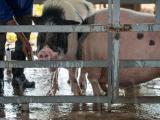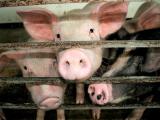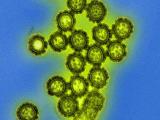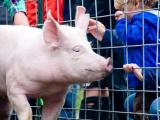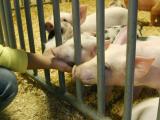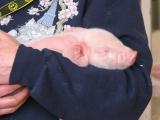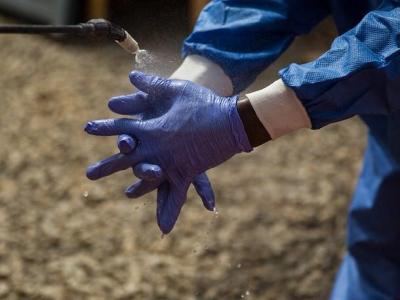Aug 15, 2012 (CIDRAP News) – Testing of a sampling of pigs shown at the Minnesota State Fair during the 2009 H1N1 influenza pandemic revealed that 19% of them were infected with flu viruses, even though they looked healthy, according to a new study.
The findings highlight the challenges of preventing pigs and humans from passing flu viruses back and forth at fairs and swine shows, especially this summer when several states are tracking human illnesses from a novel H3N2 virus that has been detected in both pigs and people.
The study, which appears today in Emerging Infectious Diseases (EID), was conducted by researchers from the University of Florida, University of Minnesota, South Dakota State University, and University of Iowa, along with scientists from the US Centers for Disease Control and Prevention (CDC).
With the goal of watching for influenza A viruses in show pigs, the group recruited people ages 7 and older who were showing pigs at the Minnesota State Fair in 2008 and 2009 and the South Dakota State Fair in 2009. Participants filled out a questionnaire and allowed the researchers to collect nasal swab samples from their pigs. Just over 70% of participants were male, and the median age was 34.9 years. About a quarter of the pig handlers were younger than 18.
They used the CDC's real-time reverse transcription polymerase chain reaction (rRT-PCR) tests to screen the samples for influenza A viruses. Blinded samples were sent to the Minnesota Veterinary Diagnostic Laboratory in St. Paul, where rRT-PCR testing for matrix, hemagglutinin, and neuraminidase genes was done, and specimens were sent to the National Veterinary Services Laboratory in Ames, Iowa, for molecular and genetic sequencing studies.
Specimens were collected from 149 pigs, including 47 and 57, respectively, from the Minnesota State Fair in 2008 and 2009 and 45 from the 2009 South Dakota State Fair. All of them were assessed as healthy by a veterinarian before they were cleared to enter their shows.
In 2008, investigators found no evidence of influenza A, but 12 (12%) of the 102 sampled collected in 2009 tested positive. These included 11 (19%) of the 57 samples from the 2009 Minnesota State Fair, which coincided with the second wave of the 2009 H1N1 pandemic.
Culturing yielded seven flu isolates. The CDC sequenced 5 of the 7 isolates and found that four were similar to the 2009 H1N1 sequences. They classified the fifth isolate, which came from a pig at the 2009 South Dakota State Fair, as a triple-reassortant H1N2, similar to recent US swine isolates.
A phone survey of the study participants found that two had experienced flulike illnesses within 7 days after being at the fair. One was a man who got sick a day after his pigs arrived at the fair; and the other was his daughter, who started having symptoms on the last day of the fair. The child's three pigs all tested positive for influenza A.
Because most of the animals were sampled within 24 hours after arriving at the fair, the researchers concluded that the infected pigs were probably infected before they arrived. Absence of apparent illness in the pigs that tested positive suggests exposure to apparently healthy pigs at shows as a potential source of influenza A transmission, the team concluded.
New reassortants could emerge and spread to humans who have contact with pigs that don't show any symptoms, they added, which underscores how important it is for clinicians who care for patients with influenza A infections to ask about pig exposures, especially when flu viruses aren't widely circulating.
Because of the risk of reassortment in pigs and new viruses passing between humans and pigs, better surveillance is needed to quickly identify emerging threats, but there are big obstacles to overcome, such as a perceived economic threat to the pork industry, the article says. It suggests that more surveillance collaborations are needed among different stakeholder groups, because people who work with pigs, including show animals, are at high risk for zoonotic infections.
Gregory C. Gray, MD, MPH, lead author of the study, said it's not surprising to find pigs that were infected with flu viruses but not visibly sick. Similar findings have come from recent studies in pigs in Canada and Spain. In the Canadian study, about 90% of infected pigs had no signs of illness.
"It differs by strain and by concomitant other pathogens," Gray told CIDRAP News. "But it's no surprise that some pigs can be infected and spreading a virus without signs. It's certainly true for humans." Gray is professor and chair of the Department of Environmental and Global Health in the College of Public Health and Health Professions at the University of Florida in Gainesville.
Gray also said it wasn't particularly surprising to find no infected pigs in the 2008 sampling. As in humans, flu infections in pigs are generally transient, he commented. Also, pigs that are sent to shows are often raised in special environments such as hobby farms, where they may have less exposure to flu viruses than commercial-production pigs have.
The new EID study is one of only a few that have looked specifically at influenza A viruses in show pigs, but more research efforts are under way. In 2009 a group from Ohio State University's Animal Influenza Ecology and Epidemiology Research Program launched a 4-year study to test county fair pigs for influenza A.
Two of the researchers recently told CIDRAP News that they have seen the virus types change over the study period. In 2009 they found just H1N2 and H3N2 swine flu viruses, whereas this year they have been finding only the novel H3N2 strain that contains the matrix gene from the 2009 H1N1 virus. This same strain, called H3N2v, has infected nearly 170 people in a handful of states this summer, mainly young people in contact with pigs at fairs.
Gray expressed concern today at how little is known about the prevalence of the novel H3N2 strain in pigs.
"Were concerned that . . . this reassortant virus from the pandemic virus might have a wide distribution, but we don't have any information on how widepsread it is in North America or in the rest of the world," he said. "We need to do more comprehensive studies of influenza in pigs, in a way that doesn't hurt the pig industry and doesn't alarm people."
Gray GC, Bender JB, Bridges CB, et al. Influenza A (H1N1)pdm09 virus among healthy show pigs, United States. Emerg Infect Dis 2012 Sep;18(9) [Full text]
See also:
Aug 9 CIDRAP News story "Illinois confirms novel H3N2 cases as national total hits 152"
Aug 8 CIDRAP News story "Variant H3N2 cases surge in Indiana, Ohio"
